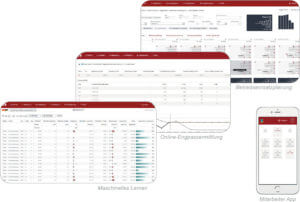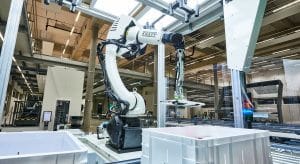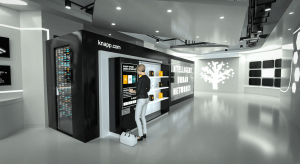Everything runs on information these days and, naturally, this is equally true for logistics. In our digital world, every sensor, every machine and every individual deliver enormous quantities of data. So, what can we do with it? Intelligent information is the key to success in our data-driven world. Artificial intelligence in particular is regarded as the defining trend for the future of logistics. We want to share three examples with you that show how artificial intelligence is already creating added value in logistics.
Artificial intelligence in logistics: From a chess grandmaster to an optimal warehouse operation
It was about 25 years ago that an intelligent algorithm checkmated world chess champion Garry Kasparov. Since that time, artificial intelligence has become increasingly more important, and this is true for logistics as well. What we call machine learning is incredibly useful, for example, when you want to find the best strategy to optimize the operation of a logistics system.
The modular software redPILOT Operational Excellence Solution involves this type of smart algorithm. With it, logistics providers can use their systems at maximum efficiency at all times. The software analyzes existing data such as throughput and uses machine learning to detect inefficient processes.

It then finds different options for optimization and suggests them to a member of the team, such as the shift supervisor. The redPILOT software acts as a navigation system for warehouse operation and calculates the most efficient route to operational targets: From servicing at exactly the right time, to automated staff planning, to dynamic detection of bottlenecks.
Everything’s in good hands thanks to robots with AI
As children, we learn to handle many different types of things: We know that you can throw a soft toy around without damaging it, but a perfume bottle is fragile and will shatter. What is easy for humans, however, is very difficult for a robot. To efficiently process online orders, for example, it needs brains – or in other words, AI.

The picking robot Pick-it-Easy Robot, brainchild of the technology company KNAPP, has just this type of sophisticated artificial intelligence. The special AI was developed in collaboration with the Silicon Valley startup covariant.ai. AI is very important for online retail in particular, as it enables the robot to deal with the diverse, extensive and constantly changing product range. Even when goods have reflective surfaces, the robot knows exactly where to hold them, so that they can be safely and deliberately placed in a shipping carton.
But how does the AI actually learn?
AI actually learns in a way that is similar to how humans learn – gaining knowledge by trial and error. Using special AI training methods called reinforcement learning, AI learns how to deal with different tasks and how to develop its own solutions. Artificial intelligence allows the robot to remember successful actions – such as a pair of socks is best picked up by the label – as well as those that are not successful. Pick by pick, a data-based pool of experience is established, so the robot improves and becomes more efficient for the warehouse operation, all the while working 24/7.
New digitalized shopping experience with a pinch of AI
Physical touch points are gaining more and more importance in online trade. Pick-up points, changing cabinets for click and collect orders in which the customer can immediately try on their online order, showrooms or popup stores: The opportunities to create new customer experiences and to increase profitability are many. Intelligent software is an important element here as well and forms the link between the digital and the physical shop, for example, aligning the inventories of the various locations in real time. Project RetailStore is the name of the technical project making it possible to “enter” the online shop. The concept involves an in-store system comprised of an automated mini-warehouse with robots and a fully integrated digitalization solution. This is seamless commerce, where the boundaries between online shopping and brick-and-mortar shopping truly begin to fade, and the customers can go on a digital journey right in the store.
A digital journey right in the store

This is how project RetailStore works:
- The goods are stored inside the theft-proof, miniature automated warehouse.
- A special scanner equipped for machine learning can read even information that is not machine-readable, such as imprints with lot numbers in plain text. This assures that all the goods are stored in the most space-effective way and provides a complete overview of the range.
- Equipped with attractive touch displays for digital signage, information and cross selling, 24/7 self-checkout and vending compartments, Project RetailStore is quite versatile: as an eye-catcher for product presentation, as a pop-up store in a parking lot or as a dark store for nano-fulfillment.
- Customers can take advantage of what online shopping offers, such as fast payment, and add to this physical touch points: They can take their time and browse, ask for advice, try out the goods, and immediately leave with their purchases.
Every successful shopping experience then involves a pinch of AI.
https://www.youtube.com/watch?v=zoq2OduClsk&ab_channel=KNAPPAG
Would you like to learn more about artificial intelligence and its advantages and uses in logistics? Write to us at blog@knapp.com.
Further reading recommendations

Flexible scheduling, better integration of employees, less organization needed, etc. The new app from redPILOT Operational Excellence Software opens up new opportunities for optimizing logistics operations and also provides attractive advantages for employees.

How to translate the one of a kind features of brick and mortar stores into unique customer experience? The new in-store system Project: RetailStore helps with this tasks.

Machine learning is everywhere. But what exactly lies behind this future technology? Is it really possible to teach machines to learn? What advantages does it offer– and where does KNAPP come into play? Let’s take a closer look.
Additional Information
![]()
What is …?
AI stands for artificial intelligence and describes computer systems that are capable of learning and thinking like human beings.
Machine learning is a branch of AI. Algorithm learning is data-based; predictions and decisions are made without specific programming.
Reinforcement learning is a popular method of training artificial intelligence. It runs through tasks, actions and possible solutions. When it is successful, the AI is rewarded.
